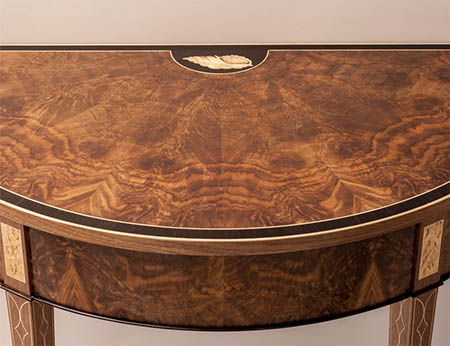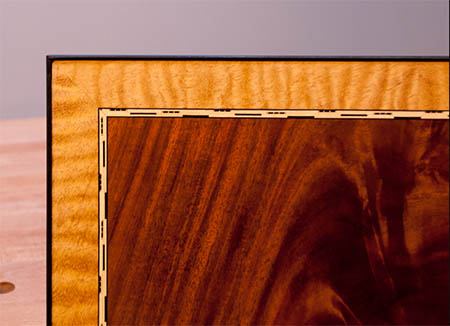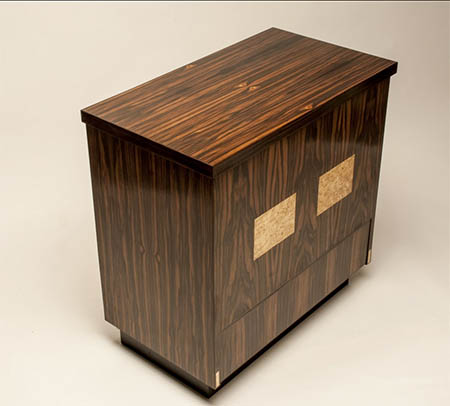
For Roger Myers, woodworking is a second career. Although he was involved in woodworking while working in his corporate career in the manufacturing and engineering field, even to the point of serving as president of the Guild of New Hampshire Woodworkers, it was after his retirement that he opened his woodworking business.
Roger also went back to school, studying furniture at the prestigious North Bennet Street School. He and his wife had heard some friends of his give presentations about the school at a conference on 18th century woodworking, and when they came home, “She asked me I ever thought about attending North Bennet Street School, and I said, ‘Well, anybody that’s been working with wood has, but it’s expensive and I won’t get in.’ And she said, ‘Well, I think you ought to try. So I applied and was accepted. That was a quick entry to, really the higher end of woodworking, if you will.”

The North Bennet Street School experience, Roger said, “was an opportunity to really embrace the craft and take whatever skill set I had and try to develop it further.” He feels he came out of the school with “the ability to analyze and solve just about any problem that comes up in woodworking, whether it’s how to construct something with the appropriate joinery or how to deal with an issue that comes up. It’s just a quest for total perfection in what you do. It’s not almost good enough. It’s right, or it’s wrong.”

Although his interest at that time and before had been mainly American period furniture, such as Queen Anne and Federal styles – Roger was a regular visitor to the annual conferences of the Society of American Period Furniture Makers – he has since branched out in the styles he works in.
“What I don’t do, is I don’t do typical interior cabinets – kitchen cabinets or even built-in. It’s primarily freestanding custom work.” And, he does still maintain somewhat of a period touch, with a focus on incorporating hand tools into the process. Although he may prepare his stock with power tools, “hand planes and scrapers touch just about every piece.”
He’s also quite fond of embellishments, particularly inlay and banding. “I like to use inlay to enhance a piece,” he said.

A couple of recent music stands, the Beethoven and the Wagner have some unusual embellishment: the banding on the music stands incorporates actual music from the respective composers. “It’s not just a typical music stand, as beautiful as they would be on their own,” Roger said.
He’s also quite proud of a piece that belonged to a client he’d done previous work for. In this case, a Lane hope chest that belonged to the client’s mother had been painted during the antiquing phase of the 1970s or 80s, “and it was this hideous red over green antique paint,” Roger said. “He asked me to take a look at it to see if there’s anything I could do to save it, and I rebuilt some of the structure and completely veneered it in Macassar ebony and Karelian birch. It took it from a 1950s piece that had been redone in the 1980s and gave it almost an Art Deco look of the 1920s that fit in with some collections he had.”

Part of his choice of the Karelian birch for that project was due to its interesting grain pattern, Roger said. Although he has a particular fondness for mahogany and cherry because of his background in traditional American furniture, “I just enjoy the beauty of wood,” he said. “The material speaks to me, the beauty that lies within different pieces of wood. Oftentimes, you can see a beautiful piece of wood, but you don’t yet know what it’s supposed to be – but you know that it’s got a special purpose.”
One of his most recent pieces was a cabinet made out of black limba and bird’s-eye maple. “I’d never used black limba before, and I just loved it,” Roger said. He also enjoyed a shelf made out of spalted sycamore.

This year, Roger was an Invited Artist with the New Hampshire Furniture Masters Association, with his work displayed at their October 1 gala. “It’s quite an honor,” he said. “I’m continuing to learn and to aspire to hit the level of some of these people who I really look up to – and you’re never too old to it.”
Roger himself has previously served as a business adviser to the organization, as well as being involved in the board of their nonprofit aspect, which recenty had a name change to the American Furniture Masters Institute “to reflect the fact that we’re doing things in more than just New Hampshire. We have a wonderful woodworking community here in the Northeast, a lot of knowledge and collaboration and sharing among the woodworkers.”
For himself, Roger said, a big part of the appeal of woodworking is “the ability to leave something behind that’s tangible. Many of the things that we do in our corporate life, they may have benefit for the moment, but they’re long since forgotten. When you’re creating something, you create a piece of art or a piece of furniture, hopefully it’s going to be enjoyed for generations.”





